White Garden
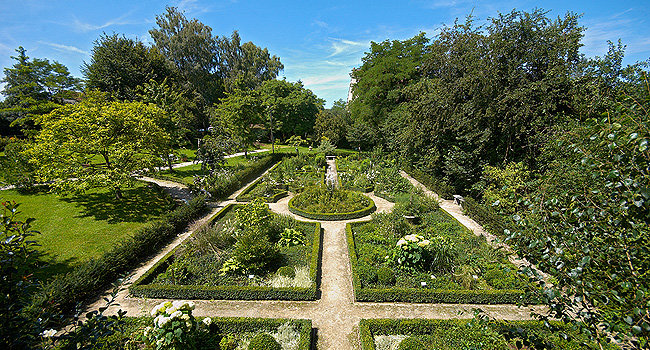
A special garden has been created in the extensive Castle Gardens. From the first signs of spring until the last days of autumn this garden blooms in all variations of white. Let the brightest of colours make an impression on you. Enjoy the peace in this oasis and treat yourself to a rest on one of the park benches. We will be pleased to bring you a glass of wine from our cellars.
In the western world, white equates to purity. For this reason brides wear white wedding dresses and health workers wear white clothing. Marvel at the different shades of white, from cream to pure white. Relax, take it easy, let the garden work its magic on you.
Leisure Facilities
Fun and wonderful adventures in nature for the little ones
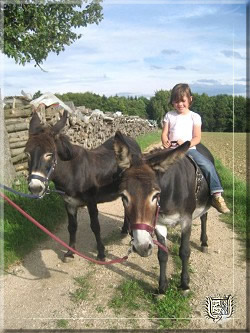
Donkey rides and shorter or longer guided donkey treks to Eggersberg Castle.
We walk with your children on the backs of our meek donkeys over fields and meadows, or through the woods along the Jura trail and back to the castle. Our lovely donkey guide, Elisabeth Baumgartner, looks forward to showing your children the unspoilt natural surroundings of Eggersberg Castle.
Call the Schwarz family at the castle on +49 (0)9442 91870 and agree a date for an afternoon or a weekend. Or send us a message.
Eggersberg Donkey Rides - min. 40 minutes, €15.00 / person.
Longer donkey treks possible by agreement.
Eggersberg Castle - the Viewing Rock
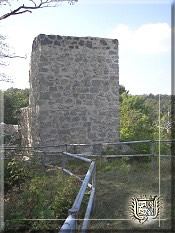
Just a few paces from "New Eggersberg Castle", a well paved path leads to one of the loveliest viewing rocks in the lower Altmühl Valley.
Today, where the proud Eggersberg Castle, home to some famous - and also infamous - families once stood, only the apse of the Chapel of the Holy Cross, which was allowed to fall into disrepair in the 19th century, can be seen.
Two excellent altarpieces from the 16th/17th centuries, which furnished this chapel, can also be admired in the Hofmark-Museum at Eggersberg Castle, as can the monstrance, which contains a verified particle of the cross of Christ, and which was donated to the chapel by Joseph Baron de Bassus.
From the viewing rock, one can look down to the left into the valley of the Old Danube, which flowed here before it broke through the limestone rocks at Weltenburg.
Early on, attempts were made to connect the Main to the Danube. The Fossa Carolina (also known as Karlsgraben) was a connection between the Swabian Rezat river and the Altmühl and thus between the large river systems of the Rhine/Main and Danube. The Karlsgraben was the forerunner of the Ludwig Canal, which was completed by King Ludwig I of Bavaria as well as today's RMD (Rhine-Main-Danube Canal). All canals had to and still must cross the European watershed.
The most popular theory assumes that in 793 Charles the Great had an approximately 3 km long canal excavated in today's Graben near Treuchtlingen. The aim of the undertaking was the replenishment of supplies for Charles' war against the Avars, who had invaded Bavaria in 788.
The canal of King Ludwig I can still be seen from the viewing rock below Eggersberg Castle with an original sluice and a restored sluice house.
Further back on the left hand side, the tower of the old fortified church of the monastery of Altmühlmünster can be seen. This area was already settled in the dim and distant past. The Altmühl and the large church (minster) influenced its name.
One symbol of the Order of Saint John is the bowl above the main entrance to the church, which you may notice. Their coat of arms shows a bowl with the head of St. John. The Order of St. John and the Knights Templar ruled over Altmühlmünster in the middle ages; later the Order of Malta took control. Perhaps you could take a walk from Eggersberg to Altmühlmünster and from there up to the Rosskopf. You are sure to like it...
Right in the background, the crosswise Wolfsberg hill can be seen from the viewing rock of the Eggersberg castle ruins, under whose topsoil an ancient Celtic fortified town, or Oppidum, is hidden.
Turning one's glance to the right, two modern wind turbines can be seen on the opposite hillside. They stand on the ground of the Jachenhausen stone quarry, the site where one of the few examples of an "original bird" the archaeopterix, was found. The smallest dinosaur in the world, and also the most bloodthirsty, which hunted in groups, the "Compsognathus longipes" was also found here. The first models of both can be seen in the Hofmark Museum at Eggersberg Castle.
The new canal, edged by preserved abandoned channels of the Altmühl, which once meandered through this wonderful valley, cannot be missed
...a view that is well worthwhile!
Rosenburg
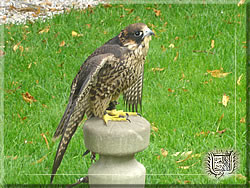
http://www.falkenhofrosenburg.de
Just a few kilometres from Eggersberg Castle the Rosenburg Castle towers over the town of Riedenburg (today in the hands of the Bavarian Castles and Lakes Administration).
The impressive history of the Burgraves of Riedenburg, who were renowned minstrels in the Middle Ages, is long gone. Today, the Rosenburg houses one of the best Bavarian state falconries. A visit is highly recommended.
Riedenburg Crystal Museum
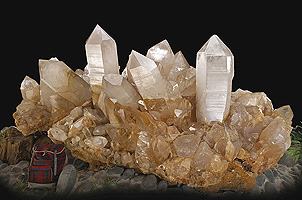 http://www.kristallmuseum-riedenburg.de
http://www.kristallmuseum-riedenburg.de
Are you familiar with the largest known mineral aggregate in the world? You won't believe it, but it can be marvelled at and admired in the Riedenburg crystal museum in the lower Altmühl Valley. And there's much more on the interesting topic of crystals and precious stones too. It has to be seen to be believed!
Plankstetten Monastery
 http://www.kloster-plankstetten.de
http://www.kloster-plankstetten.de
Have you heard of Plankstetten Monastery? This Benedictine monastery was founded as an episcopal proprietary monastery in 1129 by Count Ernst VI with the support of his brother, Gebhard II of Eichstätt and Harwig, who was the reeve of Eichstätt.
Not only the historic background and the imposing building are worth a visit; the monastery shop attracts visitors with the scent of homemade organic bread and hearty sausages from the in-house organic butcher's shop.
Benedictine Abbey of Weltenburg
 http://www.areion.org/weltenburg
http://www.areion.org/weltenburg
The Benedictine Abbey of Weltenburg is located directly in the opposite direction, right at the entrance to the romantic Danube gorge. Founded by the Celtic-Columban wandering monks, Eustasius and Agilus of Luxeuil (Burgundy) in around 600 AD, Weltenburg Abbey is the oldest monastic settlement in Bavaria.
The abbey church, which was built and embellished by the Asam brothers from 1716-1739 under the then abbot, Maurus Bächl (1713-1743), is among the outstanding achievements of the baroque period in Europe.
Don't forget to sample the famous dark beer!
Befreiungshalle (Hall of Liberation)
 http://www.kelheim.de/poi/befreiungshalle_kelheim-1610
http://www.kelheim.de/poi/befreiungshalle_kelheim-1610
A visit to the Hall of Liberation is a must on the way back from Weltenburg. Commissioned by King Ludwig I, it was begun by Friedrich v. Gärtner and completed by Leo v. Klenze in 1863. It commemorates the victorious battles in the Wars of Liberation from 1813 to 1815 against the troops of Napoleon.
Golf Club in Neuburg an der Donau
The Wittelsbach golf Club in Neuburg an der Donau is a must for golf lovers. Admittedly it is 60 km away, and takes between 45 minutes and 1 hour to get there. But once there, they will find a club of the very highest quality!
Weigand Family
The Munich lawyer, Robert F. E. Weigand, doctor of canon and civil law, founder and honorary chairman of the German Castles Association (DBV) State Committee for Bavaria, and founding member of the Bavarian State Monuments Council among others, (who died in his 91st year, November 2011), acquired Eggersberg Castle in 1962. In order to put the establishment on a firmer financial footing since there were no longer any significant estates, it was initially run as a guest house by the then mistress of the castle, the artistic and culturally-minded Ingeborg Weigand, and then as a small hotel and restaurant, whose first tenant was a Baron Knigge. The decision to enter the hotel / restaurant trade was taken so that the former Hofmark could be opened to the public. Sensitive renovations retained the authentic character of the Renaissance castle.
In the years that followed the western façade and the ruined castle mews were restored in line with the rules governing the protection of historic monuments at great financial cost. The mews are being re-roofed with Jura slate. At 50 metres in length, this will be the longest traditional slate roof in the Altmühl Valley. The village of Eggersberg has the inexhaustible dedication of the castle's owner, Dr. Weigand, to thank not only for the tarred road, which runs along the old, so-called Todensteig (death trail) from Untereggersberg to Obereggersberg, but also, due to the needs of the establishment, to a large extent for the electrification and connection to the mains drainage, which in part runs over Sauberg hill, which belongs to the castle. The initial ideas that developed into what is today the flourishing Altmühl Valley nature reserve, were discussed in detail between Altlandrat Lang and Dr. Weigand at Eggersberg. The Order of Merit of the Federal Republic of Germany and many other honours bear witness to the approval that his cultural activities found.
The "Hofmark Museum" was opened following the establishment of a non-profit foundation in 2004; it displays exhibits, some outstanding, gathered throughout a lifetime of collecting and covering subjects such as "small antiquities", "Hippologica - the horse in art", "Baron de Bassus, patron of the arts and illuminati", "the longest Celtic belt in the world" and more.
In 2007 Dr. Weigand passed the castle to his daughter and sole heir, Marion J. Wenzl-Sylvester, who, together with her husband, H.-P. M. Tassilo Wenzl-Sylvester is now following in her father's footsteps. They began to restore the interior of the house, to lay out a baroque "white garden" on the former riding arena, which had been abandoned following the cessation of hunting on horseback, and to expand the English landscape park to include a scented oasis.
The modern baroque rectory, an axial building by the architect Gabriel di Gabrieli, who designed it in 1772 by order of the Baron de Bassus along the lines of northern Italian palaces, was also restored.
Next they turned to the overgrown, former site of Eggersberg Castle (probably 11th century), which held the remains of the baroque Chapel of the Holy Cross, renovated this site and opened it to the public. The authorities generously participated in this work due to its complicated nature resulting from its exposed location. The result was that an additional wonderful viewing point over the lower Altmühl Valley immediately became available to visitors from near and far. The Wenzl-Sylvester family was honoured for this in 2011, being awarded the Bavarian Monument Medal by the Bavarian Minister for Science and the Arts, Dr. Wolfgang Heubisch.
Art exhibitions, garden markets and a sophisticated range of goods from the kitchen and cellar make Eggersberg a popular base for cultural and cultivated events.
The Wenzl-Sylvesters, a short introduction
The Sylvesters are a noble family who were domiciled in Rovigo and Ferrara/Veneto from the 9th century, and which in the 10th and 11th centuries branched out into Brittany and England, establishing three lines. At the beginning of the 17th century, Giles de Sylvester founded a trading company, "Sylvester & Coit" in Leiden in the Netherlands, which first and foremost saw success in the tobacco and spice trade. His sons, Constant and Nathaniel, emigrated to the New World; Constant founded the "Constant" and "Carmichael" sugar plantations on Barbados, whilst Nathaniel acquired "Shelter Island" just outside New York, where, with the approval of the English king, Charles I, he built a manor house. "Sylvester Manor House" was the northernmost plantation in the USA. As a result, the cosmopolitan Sylvester family has been domiciled in the USA as merchants, lawyers, politically active Congressmen and royalists since 1643.
The Wenzls originally came from the Duchy of Teschen in eastern Bohemia and are first mentioned in the 13th century. In the 16th and 17th centuries branches of the family settled in Austria and Bavaria. In the 19th century Dr. Johann Baptist Ritter von Wenzl became personal physician to King Ludwig I, whilst his nephew, the ophthalmologist, Baron Wenzel, was personal ophthalmologist to both the English King George III and the Austrian Queen Maria Theresa. Emory de Sylvester's second wife was Alice von Wenzl, a niece of Dr. Johann Baptist Ritter von Wenzl.
As a lawyer and deputy, William L. de Sylvester, who, as a politically involved newspaper proprietor published one of the leading fashion magazines in the USA, the "Pictorial Review", with his nephew Wilhelm Paul Ahnelt, swore allegiance to the Constitution of the United States of America in 1921. With this, the family divested itself of its titles, but not its nobility.
The Wenzl-Sylvester family is as committed as the late proprietor of the establishment, Dr. Robert F.E. Weigand, to the authentic preservation of the former Hofmark of Eggersberg Castle, and continues to open the house and surrounding grounds to the public. The fostering of cultural events and the maintenance of the foundation's Hofmark Museum are tasks to which the family is especially dedicated. Now the next generation is preparing to take on an active role in the shape of the two daughters, Alexandra and Marie-Louise.
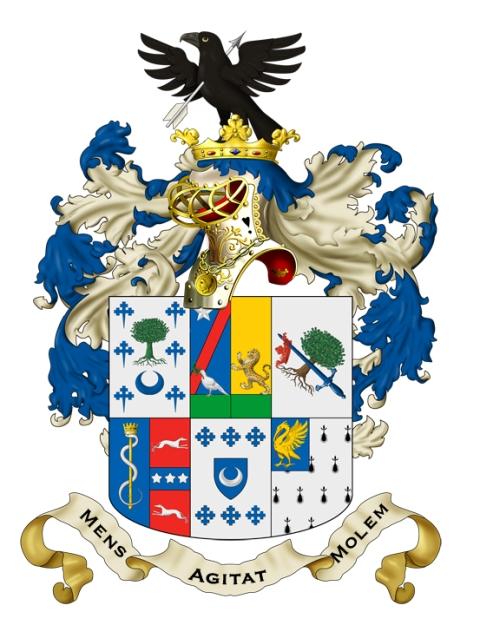
The motto of the Wenzl-Sylvester alliance coat of arms is
MENS AGITAT MOLEM
"The mind moves the matter"
Principio caelum ac terras. Camposque liquentis. Lucentumque globum lunae; titaniaque astra. Spiritus intus alit: totamque infusa per artus mens agitat molem: et magno se corpore miscet.
In the first place, an indwelling spirit nourishes heaven, earth and the watery levels, and reason moves the whole universe, is infused through all its limbs and mingled with the mighty frame.
Virgil (70 - 19 BC)
AENEID VI - verses 724 to 727
Eggersberg Presbytery
The Obereggersberger Presbytery
built based on Italian palaces in 1722
on behalf of Joseph Baron de Bassus
by the Prince Bishop's Court Master Builder
Gabriel de Gabrieli

New slate roof / Jura roof in 2006.
The rectory is privately owned.
The chapel of the rectory is available free of charge to the residents of Eggersberg as required for prayers and masses. It is possible to visit the chapel, which is fitted out in the style of the 19th century, by application to the castle.
Literature / Sources:
Dr. Sixtus Lampl - former senior curator at the Bavarian State Office for the Care and Preservation of Ancient Monuments.
Franz Seraph Scheibl - "Chronicle of the Parish of Eggersberg", from 1st Oct. 1829
Anna Höcker - Eggersberg Parish 1438 - 1988
Eggersberg Ruin
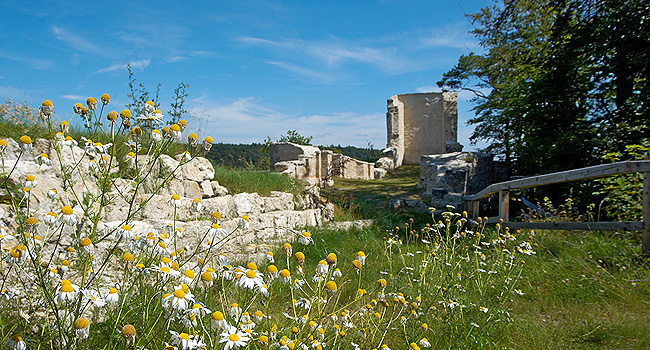
The site of the old Eggersberg castle, also known as "Kirchfelsen" (Church Crag) or "Aussichtsfelsen" (Vista Rock), with its viewing platform and wonderful, expansive view into the lower Altmühl Valley, the restored remains of the Chapel of the Holy Cross, which are now accessible, and the three-stage terrace in front of it, is a very romantic spot. Open-air plays are planned, and at weddings the setting offers a lovely backdrop for photographs, in short, a romantic "location".
The Counts of Hirschberg, and also the Counts of Rosenburg have been mentioned as the builders of the first stone castle. However, no exact details are recorded. From the 13th century, Eggersberg Castle was in the possession of the Dukes of Bavaria. The best known lord of the Hofmark (an area where the lord exerted simple jurisdiction) was Leonhard von Eck, doctor of canon and civil law, who ruled Bavaria as "first counsellor" for 35 years (1480 - 1550).
Eggersberg Parish
Monstrance with Particle of the Cross
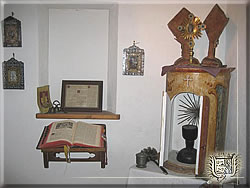
In 1721 Joseph, Baron de Bassus brought a small, silver gilt monstrance to Eggersberg, which has a cross of quartz at its centre. This crystal cross contains a verified particle of the cross of Jesus. Baron de Bassus donated this monstrance to the chapel that he had commissioned, which was built on the castle rock and which henceforth bore the name "Chapel of the Holy Cross".
The monstrance is preserved with its original sheath and can be seen in the Hofmark Museum, alongside other endowments from the Eggersberg parish.
The two altarpieces in the Chapel of the Holy Cross, which come from the Titian School in Munich, are also important. The left-hand image, the "Presentation of Mary in the Temple" shows the coat of arms of the Counts of Toerring (Bavarian ancient nobility), whilst the right-hand image shows the coat of arms of the patrician von Ammon family of Nuremberg.
The Eggersberg parish dates back to the first Romanesque chapel in Georgenbuch, which was founded in 798 and belonged to the monastery of St. Emmeram in Regensburg.
The churches in the parishes of the old Eggersberg Hofmark
Summarised June '07, H.-P.M. Tassilo Wenzl-Sylvester
The imposing structure of the Renaissance Eggersberg castle towers over the wonderfully charming Altmühl Valley on the sparse Jura plateau. The parish of the former Eggersberg Hofmark was one of the smallest in the Regensburg diocese. Nevertheless, it has an eventful history.
The rivalry between Eggersberg Castle and the parish church of Georgenbuch is noteworthy. Something that has elsewhere been sought in vain has been preserved in this parish church - the sculpted stone walls of a portal from the Romanesque origins of the church. Dr. Robert F.E. Weigand, lord of the castle at Eggersberg since 1962, prevented its demolition and thus protected this important cultural edifice from irrevocable destruction.
The animal and fable figures of this Romanesque portal are shrouded in secrecy, yet still move people today; however they will not reveal the final secrets of their origins and builder.
Worthy of mention is
that the rectory of Georgenbuch was not located on this site, but on the site of the castle and later the "new" Eggersberg Castle, in Obereggersberg. The rectory was built there on the foundation walls of a medieval castle chapel. At the rear of the rectory above the exit door is a relic from this time, a stone illustration of God the Father dating from 1593 that is embedded in the wall.
The baroque rectory, an axial building, was constructed on behalf of Baron de Bassus in 1722 modelled on Italian palaces by no less than the Prince Bishop's court master builder from Eichstätt, Gabriel di Gabrieli.
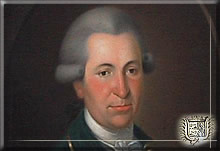
Alongside Georgenbuch and Obereggersberg, the Hofmark of Harlanden should also be mentioned in the parish of Baron de Bassus. The small church there is only unprepossessing from the outside. Inside it houses works by the Altmannstein sculptor, Johann Georg Günter. This was the father of no less than the famous Rococo sculptor, Ignaz Günter, who was sponsored by Thomas, Baron de Bassus.
This brief introduction to the historic parish of the time-honoured Eggersberg Hofmark makes it clear that there is much of importance to be seen here.
Historical Overview
From the beginning a castle chaplaincy with castle chapel was established in the early medieval Eggersberg fortress, which lies on the 90 metre high, steep rocky outcrop above the Altmühl Valley. As long ago as the 9th century this belonged to the Monastery of St. Emmeram in Regensburg.
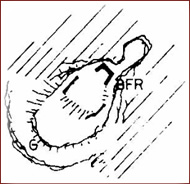
(Layout plan of Eggersberg Castle: modified after F.-W. Krahe - Burgen des deutschen Mittelalters (Castles of the German Middle Ages), 1998. An architectural schematic diagram of the castle was produced by the architect, Dr. Landgraf, and can be seen in the Hofmark Museum.)
This was the start of a centuries-long tug of war between Georgenbuch and Eggersberg concerning the importance and predominance of the parishes. Not only the respective lords of the Hofmarks but also the local priests repeatedly attempted to move the title from Georgenbuch to Eggersberg.
After the decline of Eggersberg Castle in the 16th century, the castle chapel also disappeared. The people of Eggersberg, now without their own place of worship, had to go on foot to the hamlet of Georgenbuch if they wished to attend a church service.
In 1720, the then lord of the Hofmark, Joseph, Baron de Bassus, pursued the plans of his father, who had passed away in 1704, and built a new chapel on the castle hill. To reinforce the site of Eggersberg as the pre-eminent parish, in 1722 Joseph de Bassus also had the rectory in Obereggersberg rebuilt on the site of the previous building dating from 1593 - as already mentioned, this was by the Prince Bishop's Court Master Builder from Eichstätt, Gabriel di Gabrieli. The stately form of the axial building, which is based on the architecture of Italian palaces, resembles the rectory in Schambach, which was also built by Gabriel di Gabrieli, in terms of its proportions, façade structure and service window.
In 1736 the construction of the new church on the castle rock was completed. It did not, however, enjoy a long life. As early as 1806 (note: Bavaria became a kingdom by the grace of Napoleon), the roof collapsed, as a result of which Georgenbuch once again became the parish church. On the site of the castle ruins, the three sides of the apse of the castle chapel can still be seen from the viewing rock today. On the inside of the apse (picture bottom left), the visitor can still see the remains of a red colour, which then was made from ox blood.
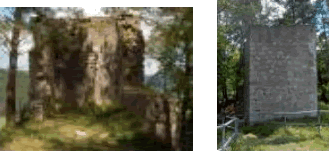
Apse of the Chapel of the Holy Cross on the castle rock of Eggersberg
(Author's note: the viewing rock has been secured and opened to the public. Entry to the privately owned, unsecured castle ruins is not advisable and is at your own risk.)
From the viewing rock it is possible to see one of the loveliest views in the lower Altmühl Valley - the Rhine-Main-Danube Canal*, which runs past the foot of the mountain, the left meander of the abandoned channel of the Altmühl and a small part of the old Ludwig Canal (King Ludwig I) with a restored sluice house dating from the 19th century. Looking to the left along the edge of the forest, it is possible to make out the steepletop of the church of the former commandery of the order of the Teutonic knights in Altmühlmünster. From there, incidentally, there is a lovely hiking trail to the next viewing point, the Rosskopf.
The lord of the Hofmark who followed on from Joseph de Bassus, Thomas, Baron de Bassus (a member of the Illuminati, code name "Hannibal") now had a problem. The people of Obereggersberg, numbering 53 souls, once again had to walk to Georgenbuch, a village of just 17 inhabitants at that time, to take part in church services. For this reason, in 1807 Thomas de Bassus had a simple house chapel built in his Hofmark's "New Castle". Its round arched windows can still be seen today on the eastern side of the building on the ground floor.
In the meantime, however, the de Bassus family had concentrated their base in the Hofmark on Sandersdorf Castle near Altmannstein. The Eggersberg Hofmark Castle was only still used as an agricultural establishment and mostly only as the rallying point for hunting trips. The grandeur of the castle and chapel suffered greatly as a result. In 1873 the then parish priest, Lukas, complained bitterly to Baron de Bassus:
"The entire castle courtyard is a colossal manure heap; on the way to the chapel the priest must work his way through this manure heap on the one side and 4 stable doors on the other along the narrow pathway."
Furthermore, he complained that he chapel was anyway only half of the former hall, whilst in the other half the large vessels stood in which the feed for the pigs was boiled. The smoke from the cooking and the smell from the stables and manure made celebrating a church service unbearable.
This caused the de Bassus family to relocate the chapel again and bring it from the castle to the rectory in 1875. There in the years 1897/98, an altar apse was added to extend the interior of the chapel. The priest objected to a larger extension to the apse. This resulted in the chapel again not being large enough, and the Georgenbuch site now definitively became established as the site of the parish church. There the Romanesque nave building had been extended by 20 feet in 1833.
At that time, the nobles of Harlanden had their own manor there. This led to the somewhat curious fact that the subsidiary church of Harlanden was not allotted to the nearby Georgenbuch, but to the parish of Altmühlmünster, the former commandery of the Teutonic knights.. This made it necessary for the Harlanders to pass through the parish territory of Georgenbuch on their way to church. As this circumstance was not sustainable, Harlanden, contrary to the protests of Altmühlmünster, was incorporated into the parish of Eggersberg in 1837.
Today, Georgenbuch and - now and again - also the rectory chapel in Obereggersberg are attended by the town pastor of Riedenburg as provisor.
History of Eggersberg
Pre- and early history
Even in pre- and early history, the Altmühltal valley was a popular settlement area because of its fertile side valleys, the rolling hills and the streams, which were rich in fish .
Entire Celtic towns, so-called "oppida", were built around the 8th century bc. One was situated at "Wolfsberg" not far from Eggersberg. Further settlements were located at the foot of the castle rock .
This was proven with the find of a large Celtic burial ground during the construction of the Rhine-Main-Danube Canal. Among the burial objects was the longest Celtic bronze belt, which now is on display in the Hofmark Museum at Eggersberg.
10th century
In the 10th century, the castle at Eggersberg was mentioned for the first time.
12th century
Eggersberg found its way into literature. The lords of Eggersberg Castle were the Nussbergers. They served the Counts of Bogen as so-called ministeriales (unfree knights).
By the way, because of the marriage of Ludmilla von Bogen to Louis I, Duke of Bavaria, the house of Wittelsbach adopted the blue and white lozenges into their coat of arms.
Konrad von Nussberg
1st half of the 14th century
Eggersberg Castle became the property of the Bavarian dukes, who gave it to the Lords of Wolfstein as a fief. At that time, the family Wolfstein of Sulzbürg was among the most important noble families in the district of the Upper Palatinate. In the course of the centuries they managed to raise from the position of imperial ministeriales to the position of imperial princes.
The current coat of arms of Sulzbürg. The two red lions are a reminder of the most important local noble family, the house of Wolfstein, who was subject directly to the suzerainty of the Emperor. Their oldest signet, known since 1292, shows two lions, one above the other. The one on the top is shown pacing, the other one is up on its hind legs. Originally, the background colour was silver. In 1740, the lineage of Wolfstein died out, but the coat of arms of Sulzbürg and Pyrbaum still serves as a reminder of the house.
The first known member of the family was Gottfried of Sulzbürg (1259), who was mentioned as imperial ministerialis for the first time in 1217. With the administration of the imperial estates in the area of Neumarkt he acquired a good reputation and power. He was married twice with women of the high nobility, by which he was able to strengthen his authority and increase his possessions.
As was customary among the high nobility, he founded the monastery Seligenporten and determined it to be the last resting place of his family. Gottfried of Sulzbürg-Wolfstein's high self-esteem was also reflected in the dispute over the throne in 1246/56, when he took sides with the antikings. In return he gained even more income.
The death of Christian Albrecht, Count of Wolfstein, in 1740 marked the end of the male line of the family. As per contract, all the imperial estates administered by the Wolfstein family were transferred to the Electorate of Bavaria. After a protracted dispute, the Bavarian prince-elector even acquired the family's private property (allodia).
2nd half of the 14th century
The family of Hilpoltstein became the lords of Eggersberg Castle.
City coat of arms of Hilpoltstein
The city of Hilpoltstein, which is settled at the Main-Danube Canal and the lake Rothsee, has a history of more than 1,000 years. Heinrich von Stein and his son Hilpolt I of the family von Stein are considered to be the actual founders of the "oppidum in Lapide" in 1280. As imperial officials in the service of the House of Hohenstaufen and later of the House of Wittelsbach, they filled a powerful position. In his capacity as imperial official, Heinrich von Stein (1254-1265) administered the imperial estates in the Bavarian region of Franconia.
14th century
In the last third of the 14th century, the Hilpoltstein family sold Eggersberg Castle to the Lords of Lichteneck, who still exist in the lineage of the Counts of Preying-Lichteneck-Moos in Lower Bavaria. Eggersberg was in the family's possession only for a short time, though.
When the Bavarian territories were partitioned between the sons of Duke Stefan in 1392, Eggersberg, Riedenburg, Stadtamhof, Reinhausen, Regenstauf, Schwandorf, Rieden, Velburg, Hemau and other places became the property of Duke John II of Bavaria-Munich.
End of 14th century
Knight Wilhelm of Fraundorf and later Knight Ulrich Muracher acquired Eggersberg Castle. The Muracher family, which also owned Flügelsberg Castle on the other side of Eggersberg, excelled in their support of the so-called "Löwlerbund" in the rebellion against Duke Albert of Bavaria.
1417
Balthasar Muracher was still mentioned as lord of Eggersberg Castle. The members of the Muracher family were dreaded robber-barons. Even in 1561, a Bavarian chronicle mentioned the unscrupulous ways in which the nobility exploited the people.
In those days, the Muracher were known for their notorious raids and bloody feuds in the entire surrounding area. Konrad Muracher of Flügelsberg was captured by the Knight Heydeck in the course of their feud and kept imprisoned from 1385 to 1394. Ulrich von Murach robbed merchants from Augsburg in 1407. Jörg, Friedrich and Erhart von Murach even raided and robbed Helfenberg Castle near Velburg, whereby they benefited from the fact that the owner, Prince-Elector Louis III, had died in December 1436.
The trade routs from Regensburg to Hemau and further along to Nuremberg were a worthwhile target for raids and forays. Similarly lucrative was the route Abensberg-Kelheim-Nuremberg, right through the Altmühltal valley and past Eggersberg, where mainly merchants from Nuremberg were among the victims.
In 1446 the robber barons exhausted the patience of the people. The Nurembergers declared war against the robber barons. In the same year an army from Nuremberg burnt down Flügelsburg Castle, which was rebuilt in later years. The castles of the knights of Altmannstein and Hagenhyl were destroyed as well.
Balthasar von Murach, who was the last in the lineage at Eggersberg, was followed as lord of Eggersberg Castle by the noble Heimeran Muggenthalter in
1435
Duke William of Bavaria gave Hexenagger Castle, which lies in the Schambachtal valley, to the Muggenthal family as a fief in 1529.
The Muggenthal family distinguished itself. Hexenagger Castle and the appertaining chapel had been destroyed by the Swedes during the Thirty Years' War, but Erhart von Muggenthal rebuilt them in 1625/29. In the course of the following centuries the Muggenthalers were raised to the position of barons of the empire.
In 1480
Marshal Georg von Pappenheim became the new owner of Eggersberg Castle, but only a few years later, in County of Pappenheim
1485
he sold it to Count Jörg von Helfenstein. The count did not show much interest in the castle, though, and left it to decay. Instead, he dedicated his time to his new wife, the widow of Johann von Hexenagger. With this marriage he came into the possession of Hexenagger Castle.
Countess Helfenstein begs ringleader Jäcklein Rohrbach to spare her husband during the Peasants' War.
Copper engraving by Matthäus Merian Sr
Mid 16th century
Eggersberg Castle was described as "desolate and decayed". It probably had been damaged during the "Löwler War".
The "Löwler War"
Duke Albert IV (the Wise) raised a general tax to recruit and pay a standing army in 1488. The Parsbergers of Flügelsberg and other fief-holding noble families of Lower Bavaria insisted on their privileges and rejected the tax. Instead they demanded full tax exemption for their rank. Duke Albert rejected such a notion energetically, though.
As a result, 46 knights met in Cham and founded the "Knight's alliance of the lion", the "Löwlerbund", with the objective of rising up against the duke. The number of the knights proliferated in no time and the division in the country grew deeper day by day. Even the duke's younger brothers joined the Löwlerbund because the duke did not acknowledge their claims to power.
The knights attempted an open revolt against Duke Albert in October 1491, because they believed to outnumber the duke's supporters. They raided and robbed the duke's estates and villages in the area of Regensburg and captured his people.
Meanwhile, the duke gathered all his supporters and allies in order to quench the revolt. On 21 December 1491, together with an army of 2,000 men and 30 artillery pieces he went from Munich to Regensburg to put an end to the outrageous actions of the Lion Knights.
After order had been restored in the area of Regensburg, the duke and his men moved on to Prunn, Riedenburg, Eggersberg, Flügelsberg and Ehrenfels near Beratzhausen. At Flügelsberg were the headquarters of the Lion Knights and many of them stayed there. To provide for their living plenty of food had been taken from the raided ducal villages.
Shortly before the actual fighting, the Lion Knights met at Prunn Castle, whose owner was Wolf Fraunberger, to hold a council of war. Fraunberger knew of the duke's recent successes and advised the knights to give up their plans. The knights, proud and under a delusion, did not want to hear about it, especially the Flügelsbergers Hans and Georg von Parsberg ignored the warnings. Instead, the knights scoffed at Wolf Fraunberger because of his alleged cowardice.
One week later, the men of Flügelsberg had to come to the bitter realisation that Wolf Fraunberger had been right.
Contrary to Fraunberger, who surrendered without a fight to the duke and whose castle still exists, the men of Flügelsberg could not save their castle. The very same day, the duke's men moved on to Riedenburg and spent the night there. At daybreak the next day, the duke divided his army into three troops. One of them made its way up to the plateau of Eggersberg Castle, which was owned by Veit von Muggenthal, to attack it from there.
Prior to that, Rabenstein Castle was taken and its owner, Knight Hans Pflug von Rabenstein, was captured. Meanwhile, the other two troops moved up the valley against Eggersberg and Meihern. Near Gundlfing a strong division separated from the rest with the objective to circle Flügelsberg from the north and to prepare an effective bombardment.
At the same time, Eggersberg Castle was stormed from two sides and taken after little resistance. Spearheads had already gathered in the area of Meihern and Deising to prepare for the storming of Flügelsburg Castle. To ensure that the division which came from the North to Gundlfing could come within gunshot range, some distraction had to be provided for. Therefore, a rollicking celebration in the camp had been arranged.
The aim was to convey the impression that no more fighting was intended. Beer, wine, meat and bread were obtained from the surrounding farmsteads. The knights at Flügelsburg Castle did not perceive the stratagem and refused Duke Albert's ultimatum. They even refused a second ultimatum being under the delusive impression that the castle was impregnable. Hence, the fate of Flügelsburg Castle was sealed.
On an agreed sign the castle complex, which must have been rather extensive, was stormed and fired at from all sides. Only on the third day (6.1.1491) and at great cost of life on either side, the duke's troops managed to get past the third and last moat and to force the remaining men back into the castle courtyard. In the process, a lot of blood had been shed again.
Because of the superior numbers, the remaining men, though fighting with the courage of a lion, had to give up the unequal fight. The Knights Hans and Georg von Parsberg as well as 18 knaves and lansquenets were taken captive.
The household and personal effects of the knights were taken to Dietfurt with 12 heavily loaded carts and left in the hands of the citizens. The Parsbergers were tied up and bound to a horse cart. They had to walk on foot to Munich, where they were kept imprisoned in the Falcon Tower for a year. Their castle was set afire after everything useful had been extracted.
Aft.r all this, the duke and his troops moved on to Ehrenfels Castle near Beratzhausen to punish even the last of the rebellious Lion Knights, Bernardin von Stauff of Ehrenfels. In this 30-day winter campaign, Duke Albert IV chastised the worst of the rebellious knights and broke the Löwlerbund's spirit and strength. One after another, the knights submitted themselves to the duke, who showed mercy with them. From then on little was heard from the Parsbergers. Flügelsburg Castle had been destroyed so they inhabited their house Meyer-Hof at the foot of the mountain in Meihern. They converted the house into a handsome castle and called themselves "Lords of Meyern, called Fligelsperg".
16th century
In the first third of the 16th century, Leonhard von Eck (1480-1550) was given the Hofmark Eggersberg and the Hofmark Wolfseck. A Hofmark was the smallest jurisdiction of the country at that time. He was one of the most important Bavarian politicians of the time. His complex policy, always focused on the welfare of his lord and Bavaria, made an impact and received credit well beyond the Bavarian borders.
Leonhard von Eck, who was of lower nobility that was not allowed to take part in tournaments, received his Doctor of Both Laws (iuris utriusque) in Bologna.
Duke William IV of Bavaria appointed him into his government in 1514. There the court councillor ("first daily councillor") was the duke's closest adviser and therefore the most important figure at the Bavarian court.
For over 35 years, he influenced the political, economic, religious and social life in Bavaria in the first half of the 16th century. The first effective approaches to a central government in Bavaria came from Leonhard von Eck. It was also due to his work, that Bavaria stayed Catholic and later on became the most important Catholic power in Germany. He had laid the foundation.
Bust of Leonhard von Eck in the Hall of Fame in Munich
At Eggersberg and at Wolfseck Leonhard von Eck was described as followes:
"He called his lord EFG, the initial letters of "Euer Fürstliche Gnaden" (German for "Your Highness"). This alone shows his sense of economy. Leonhard von Eck, of lower nobility that was not admitted to tournaments, could take such liberties. For 35 years he had been the most important person at the ducal court in Munich.
William IV of Bavaria appointed him into his governmental body in 1514. Eck received the title "Daily Councillor of Munich", free lodging, a winter and a summer garment as well as two horses.
As "daily councillor" he had to be available every single day in contrast to the "requested councillors", who were of nobility that was admitted to tournaments. Those had to make an appearance only when called upon. And then there were the "ember days councillors", who were called to court only four times a year. The daily councillors had the most influence, of course, and Eck was the most important of them.
Leonhard von Eck was born on 17 March 1480, took his Doctor of Both Laws and became an ambitious and highly talented man. According to a portrait of Bartel Beham he was also a man of utter ruthlessness.
His lord, Duke William, was not of a sensitive disposition either. When the 18-year-old duke had come into power, the representatives of the estates of the realm had been surprised by his argumentativeness and obstinacy. An envoy from Hesse observed that the duke was a proud man, who did not like to be wrong.
Still, things worked out between those two strong-willed fellows, not least because the duke realised that he could leave the daily business to Councillor Leonhard von Eck and instead enjoy the pleasures of life. He had time for art, hunting (for example at Eggersberg, which lay in a densely forested area with much game), tournaments and culinary delights. Both men were in agreement that two principles should have priority in Bavarian policy: Containment of the house of Habsburg's urge for territorial expansion and the fight against the Reformation. Thus, the Bavarian Chancellor Leonhard von Eck became one of the most violent opponents of the Habsburg Emperor Charles V.
The humanist statesman Leonhard von Eck was actually quite liberal. He took the view that everybody should be entitled to believe in what their conscience tells them to. Officially though, he extended the power of the Catholic Church in Bavaria with all his might.
He coined the phrase "Cuius regio, eius religio", whoever rules the country also determines its religion. Immediately after the emperor had placed Martin Luther under the imperial ban, Leonhard von Eck started the confessionalization in a systematic way. He created the early absolutist state, in which the political and religious identity merged.
Leonhard von Eck called the tune at the Bavarian court. Everybody who wanted to obtain something from the duke had to approach Eck first. He took the load of the daily business off the duke's shoulders, whose duties were limited to representation. This arrangement suited the duke perfectly. Still, Eck's power and influence depended solely on EFG, "Your Highness".
Therefore, Eck kept a jealous watch over his lord's favour. The ambitious chancellor lived in constant fear of a possible comedown. Even after thirty years he still felt uneasy whenever the duke sent his "daily councillors" some venison without being distinguished with an especially large piece.
The fear was unfounded, though. The duke sticked by his chancellor as long as he lived. When Duke William died, his vassal from Eggersberg, Leonhard von Eck, followed him only four days later on 17 March 1550"
Chancellor Leonhard von Eck (1480-1550),
1527, by Barthel Beham (German, 1502-1540)
Oil on wood; 22 1/8 x 14 7/8 in. (56.2 x 37.8 cm)
Collection John Stewart Kennedy Fund, 1912
Literature:
- Bibliographie zur deutschen Geschichte im Zeitalter der Glaubensspaltung 1517-1585, published by Karl Schottenloher Volume III, Reich und Kaiser, Territorien und Landesherren, Leipzig 1936 No. 29422-29437, Karl Schottenloher Volume V,
- Karl Schottenloher Geschichte Baierns, 8 Volume, II-VIII Gotha 1880-1914; I Stuttgart 2 1927, Volume IV;
- Walter Peter Fuchs, Baiern und Habsburg 1534-1536, in ARG 41 (1948), 1-32; - ARC I et seq.;
- Das konfessionelle Zeitalter. Erster Teil: Die Herzöge Wilhelm IV. und Albrecht V., in: Handbuch der Bayerischen Geschichte published by Max Spindler, Volume 2 München 1969, 297-346, here: 227-335
1595
On Leonhard von Eck followed the jurist, ducal councillor and carer of the city of Dachau, Wilhelm Jocher von Egersperg, who carried his new possession in his name. He was born in Mauterndorf, Salzburg on 15 November 1565 and died in Munich on 3 May 1636.
He initiated the construction of the new Eggersberg Castle, which was completed, according to carpenter fittings in the roof truss, in 1604.
Wilhelm Jocher von Egersperg studied law in Ingolstadt at the same time as the later duke and prince-elector of Bavaria, Maximilian I. After his doctorate in 1592, Jocher was assessor of the Bavarian Circle at the Imperial High Court until 1604.
In 1604, he entered into service with Duke Maximilian I. In 1611 he was appointed privy council. The devout Jocher, who had received a humanist education, became Maximilian's most important counsellor and as such gave his juristic advice on the Bavarian foreign and imperial policy with subtlety and astuteness. After defending the Aulic Council in the Donauwörth dispute he even came into favour at the imperial court. In 1620/21, he advised the emperor on the proscription of Frederick V. Between 1621 and 1628, Jocher acted as violent opponent of the Palatine councillor Ludwig Camerarius in the chancery dispute. With his sense of realistic possibilities Jocher repeatedly stood in contrast to Duke Maximilian's doctrinaire confessor Contzen, not least in the matter of witch persecution. Contzen supported the witch persecution whereas Jocher demanded its containment. In 1636, Jocher died in Munich.
His son Adam Jocher, who was ducal councillor himself, had the ruinous old castle knocked down. Instead, he moved into the "New Eggersberg Castle", as it still exists today.
1684
Adam Jocher von Egersperg overextended himself and went broke. What followed was the forced sale of Eggersberg.
The jurist Professor Dr.iur.utr. Dominikus Baron von Bassus from Ingolstadt bought Eggersberg, the ruin at Tachenstein and Sandersdorf Castle for 13,000 Bavarian guldens. Baron von Bassus originally came from Poschiavo (Switzerland) and was a descendent of a highly esteemed noble family.
His nephew Baron Thomas von Bassus was a leading member of the infamous "Order of Illuminati", together with Adam Weishaupt, who used the codename "Spartacus". Weishaupt's adjutant was Baron Adolph Franz Friedrich Ludwig von Knigge, who significantly helped to spread the Illuminati among nobility.
Baron Adolph von Knigge
The de Bassus family was in possession of Eggersberg Castle until 1947, longer than anyone before.
Copper engraving of Eggersberg Castle by Michael Wening. The coat of arms of the de Bassus family is shown on the top left. The family had left their mark back in Poschiavo as patrons of the art and benefactors and they kept up this tradition in Bavaria. The family acted as patron of the famous composer Johann Simon Mayr and wood-carver Ignaz Günther.
Listen to the beautiful music of Simon Mayr! Click on the notes:
Johann Simon Mayr was born in 1763 in the small village of Mendorf near Altmannstein. He studied and worked in Ingolstadt from 1773 to 1787. He was a contemporary of Haydn, Beethoven and Rossini and one of the most famous opera composers at the beginning of the 19th century.
His works were performed in the cities of Rome, Milan, Paris, Vienna and Lisbon. He is considered to be the "Father of the Italian opera". Napoleon offered him the post as director of the opera in Paris and Constanze Mozart asked him to teach her son. Mayr's most famous student was Gaetano Donizetti. When Mayr died in Bergamo in 1845, Giuseppe Verdi and Gioacchini Rossini paid their last respect.
Under the patronage of the Barons de Bassus of Sandersdorf and Eggersberg, Mayr composed 60 operas and 600 musical works for the church and chamber music, which have experienced a renaissance in recent years.
Johann Simon Mayr, "composer of the Illuminati Order"
On 22 November 1725 the Rococo sculptor Ignaz Günther was born in Altmannstein in the Upper Palatinate. At the age of 18 he was accepted to the atelier of the court sculptor Johann Baptist Straub in Munich. There, he acquired his sense for technical refinement and a certain nervous elegance, which made many of his works so popular.
Ignaz Günther
In 1750, he travelled around to Salzburg, Mannheim, Olmütz in Marovia and Vienna. There, he won the first prize of the Imperial Academy. In 1754, he moved to Munich, married and bought the house number 11 on the street "Am Unteranger". He celebrated great successes, but died at the age of only 50 years in 1775.
Ignaz Günther, who also was promoted by the Barons de Bassus, represented the peak and simultaneously the end of the Bavarian Rococo sculpture.
Some of the most important works of the carver and sculptor Ignaz Günther:
- 1752, outfitting of the parish church of KopÍivná (Geppersdorf)
- 1756, he carved the high altar of the collegiate church Neustift in Freising
- 1761/62, the high altar of the Benedictine abbey in Roth am Inn followed
- 1763, he made the group of guardian angels in the Bürgersaalkirche in Munich, corresponding exhibits are shown in the Bavarian National Museum in Munich
- 1763/64, he carved the altar, annunciation group and pietà in the Augustinian monastery in Weyarn
- 1763/64, he made the altars and the pulpit for the pilgrimage church St Anna in Munich-Harlaching
- 1763/64, he outfitted the Holy Cross Church of his hometown Altmannstein
- 1767, he carved the altars of the convent church in Altenhohenau
- 1766-68, again he designed and constructed a high altar for the church in Starnberg
- 1768-70, followed by the high altar of the church in Mallersdorf
- 1774, as well as the pieta in the cemetary chapel in Nenningen
1726
Baron Joseph von Bassus, lord of the Hofmarks Sandersdorf, Harlanden, Eggersberg and Tachenstein, had the Holy Cross Chapel built in Obereggersberg. A simple monstrance of that chapel, which contains a verified particle of the True Cross, is shown in the "Hofmark-Museum" of the Robert Weigand Cultural Foundation in the "stables" of Eggersberg Castle.
1806
Part of the chapel fell down because of inadequate maintenance. A chapel was set up in the castle, which was deconsecrated a few years later. It was replaced with the chapel in the old presbytery. The presbytery, an axial building which belongs to the castle, had been constructed by the well-known master builder Gabriel di Gabrieli by order of the barons de Bassus in 1722.
(In 1805, following Baden-Wuerttemberg, Bavaria became kingdom by Napoleon's grace.)
Things came to a halt at Eggersberg Castle during World War I. Between the two wars, Baron Bassus committed the administration of the castle to Major von Echterstab.
Unsatisfying years followed World War II. Eggersberg Castle was used as shelter for refugees. Those times affected the furniture badly and the historic building was in danger.
1962
Dr. jur. utr. Robert F.E. Weigand ( founder and honorary chairman of the Bavarian committee of the German castle association, founding member of the Bavarian Monument Council/Monument Council of Bavaria etc.) bought Eggersberg Castle. He transformed it into a hotel and restaurant business and set up the Hofmark Museum. The first person, who rented the castle from Dr. Weigand in order to run a hotel and restaurant, was again a Baron Knigge.
1994
the west façade of the house as well as the utterly ruinous stables were renovated in compliance with the preservation law for ancient monuments and historic buildings and high financial expenses. The roof of the stables was tiled and with its 50 m it is now the longest limestone roof in the Altmühltal valley.
During his long life as a collector Dr Weigand equipped the castle and the Hofmark Museum with partly rare and exquisite pieces. In 2004, he founded the cultural foundation "Dr.-Robert-Weigand-Kulturstiftung", which has its office on the first floor of the stables, to preserve the exhibits for the following generations.
The village of Eggersberg owes a lot to the untiring commitment of Dr Weigand, such as the paved road from Untereggersberg to Obereggersberg. The maintenance of the castle required electrification and access to the sewerage system.
With his tireless endeavour Dr Weigand preserved one of the most beautiful viewpoints of the Altmühltal valley, the castle rock of the ancient Eggersberg Castle, for the public.
Since 2005
More and more cultural events have been hosted at Eggersberg Castle and the Hofmark Museum has enjoyed great popularity. And the family has planned further high-class events, which promise to be a pleasure for all senses.
There is much to look forward to!























